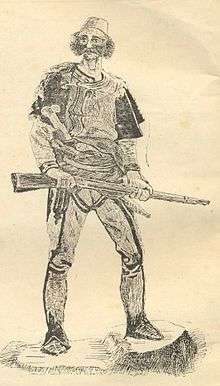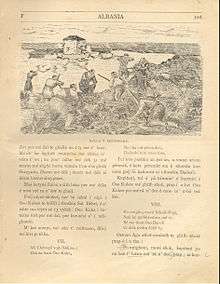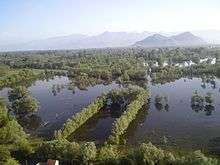Oso Kuka
| Oso Kuka | |
|---|---|
 Drawing of Oso Kuka, from the June 1901 issue of the Albania newspaper of Faik Konitza | |
| Born |
c. 1820 Shkodër, Ottoman Empire |
| Died |
1862 Vranjina, Montenegro |
| Nationality | Ottoman |
| Other names | Osman Kuka |
| Occupation | a border guard and commander |
| Years active | 1862 |
| Known for | Blowing up the tower of Vranina |

Osman agë Kuka also known as Oso Kuka (c. 1812/1820–1862) was an Albanian border guard in the Ottoman-Montenegrin border. Surrounded by Montenegrin soldiers in a tower on the island of Vranjina, he blew it up killing himself and many of the Montenegrin soldiers. In the following decades, he became a rallying figure of the Albanian independence movement and a much-celebrated character of important works in Albanian literature.
Life
Born around 1812[1][2] or 1820[3] in Shkodër, in a timariot family with early origins from the area of Kukës. His family also held several other positions in the Sanjak of Scutari, his grandfather and other relatives were kethüda of the castle. His father, Bejtullah agë Kuka, was standard-bearer of the Vezir, Mustafa Pasha. At 1859 due to the proposition of Hodo Sokoli, Oso Kuka was promoted jysbash of the border guards on the Ottoman-Montenegrin border.[1]

Oso Kuka himself had formed a 24-man band (çetë) that was active in the city.[4] At the head of a small group, Oso Kuka arrived on the battlefields where 8,000 Montenegrin soldiers had been besieging the fort of Vranjina. Kuka and his groups were defending a secondary tower in front of the main tower. When it was surrounded, instead of surrendering, Kuka planted explosives in the tower, which he activated when the Montenegrins stormed the tower and killed many Montenegrin soldiers along with his group.[3]
Legacy
Oso Kuka over the decades became a major rallying figure of the Albanian national awakening. One of the most important representations of Oso Kuka in literature is that in Gjergj Fishta's epic Lahuta e Malcis. Oso Kuka's involvement in the war and his death comprise the first five cantos also known as the "cycle of Oso Kuka".[5] Ndre Zadeja also wrote a melodrama titled Oso Kuka, based on his life.[6]
His residence in Shkodër houses the city's historical museum, while Slavic speaking population of the small village in Vranjina (modern-day Montenegro) show to visitors so-called "house of Oso Kuka".[3]
Sources
- 1 2 Bushati, Hamdi (1998). Shkodra dhe motet v. I. Shkodër: Idromeno. pp. 510–514. OCLC 645720493.
- ↑ A.J. (janar 1921). "Oso Kuka" (PDF). bksh.al. Agimi V. I, nr. 9. Check date values in:
|date=(help) - 1 2 3 Elsie, Robert (2012-12-24). A Biographical Dictionary of Albanian History. I.B.Tauris. p. 263. ISBN 9781780764313.
- ↑ "Oso Kuka, hero me vulën e popullit, jo të qeverisë". Gazeta Shqip. Retrieved 28 January 2013.
- ↑ Elsie, Robert (2006-01-08). Albanian Literature: A Short History. I.B.Tauris. p. 123. ISBN 9781845110314. Retrieved 28 January 2013.
- ↑ Banham, Martin (1995-09-21). The Cambridge Guide to Theatre. Cambridge University Press. p. 14. ISBN 9780521434379. Retrieved 28 January 2013.
External links
- http://www.bksh.al/gsdl/collect/revistaa/tmp/190106.html "Newspaper from 1896 by Faik Bey Konica"
- http://shkoder.net/oso_kuka/ "Oso Kuka – A Great Hero"
- http://argophilia.com/albania/lake-skadar.html "Lake Skadar"
- http://dome.mit.edu/bitstream/handle/1721.3/147464/204131_cp.jpg?sequence=1 "House of Oso Kuka"